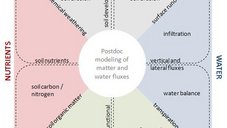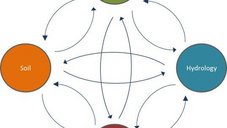HILLSlope Chronosequence And Process Evolution | Hillscape


Human activities and climate change are rapidly changing the Earth’s surface. However, our understanding of how soils change over time and how this influences ecological, hydrological and geomorphological processes is still elementary. Some soil properties are persistent, but others can change rapidly with significant effects on water quantity and quality. This is particularly true at the hillslope scale, where lateral and vertical transport processes interact over various timescales. Water and vegetation shape the surface and subsurface properties of hillslopes through weathering, soil development, and erosion.
These processes, in turn, control water flow paths. The distribution of water also affects the vegetation, while vegetation in turn also affects the flow pathways for water. Although all of these processes affect each other, their numerous interactions have only recently become a research focus. The multidisciplinary HILLSlope Chronosequence And Process Evolution (HILLSCAPE) project focuses on the vertical and lateral redistribution of water and matter along hillslopes and how this redistribution affects and is affected by soil, vegetation and landscape development. The coevolution of these processes is a novel and challenging research field.
The overall research question of the project is: How does the hillslope feedback cycle evolve in the first 10,000 years and how is this related to the evolution of hillslope structure, including plant cover? HILLSCAPE identifies the dominant controls on hillslope functioning and their feedback processes at hillslopes on moraines of different ages and thus stages in their evolution. We use a chronosequence of highly instrumented plots at two different locations with different parent material - silicate-rich and carbonate-rich - and follow an all-measurements-on-all-plots approach to ensure integration of the different datasets and insights. We determine the hillslope structure and vegetation composition at each of these plots and study the hydrological and geomorphological processes during frequent and extreme rainfall events by conducting a series of artificial rainfall experiments. The combination of four interdisciplinary PhD projects allows us to understand how hillslope structure and functioning and their feedback processes change during hillslope evolution.
The findings indicate that the contrasting properties of siliceous and calcareous parent materials lead to variations in soil structure, permeability, and water storage. As a result, different plant species and vegetation types are favored on siliceous versus calcareous parent material, leading to diverse ecosystems with distinct hydrological dynamics. The siliceous parent material was found to show a higher activity level in driving the coevolution. The soil pH resulting from parent material weathering emerges as a crucial factor, influencing vegetation development, soil formation, and consequently, hydrology. The acidic weathering of the siliceous parent material favored the accumulation of organic matter, increasing the soils’ water storage capacity and attracting acid-loving shrubs, which further promote organic matter accumulation and ultimately lead to podsolization after 10 000 years. Tracer experiments revealed that the subsurface flow path evolution was influenced by soil and vegetation development, and vice versa.
Subsurface flow paths changed from vertical, heterogeneous matrix flow to finger-like flow paths over a few hundred years, evolving into macropore flow, water storage, and lateral subsurface flow after several thousand years.
In contrast, the calcareous site possesses a high pH buffering capacity, creating a neutral to basic environment with relatively low accumulation of dead organic matter, resulting in a lower water storage capacity and the establishment of predominantly grass vegetation. Coevolution was found to be less dynamic over the millennia. Unlike the siliceous site, the subsurface flow paths at the calcareous site only altered in shape and not in direction. Tracer experiments show that flow paths changed from vertical, heterogeneous matrix flow to vertical, finger-like flow paths after a few hundred to thousands of years, which was driven by root activities and weathering processes. Despite having a finer soil texture, water storage at the calcareous site is significantly lower than at the siliceous site, and water transport remains primarily rapid and vertical, contributing to the flourishing of grass vegetation. The studies elucidate that changes in flow paths are predominantly shaped by the characteristics of the parent material and its weathering products, along with their complex interactions with initial water flow paths and vegetation development. Time, on the other hand, is not found to be a primary factor in describing the evolution of the hydrological response. These studies make a valuable contribution to closing the gap in our understanding of the coevolution of hydrological processes within the hillslope feedback cycle, which is important for improving predictions of hydrological processes in changing landscapes. Furthermore, they emphasize the importance of interdisciplinary studies in addressing the hydrological challenges arising from global change.

![[Translate to English:] feld2](/fileadmin/_processed_/c/4/csm_DSC_0532_a759b84eff.jpeg)
![[Translate to English:] feld3](/fileadmin/_processed_/a/d/csm_DSC_1161_6de6ae1b7e.jpeg)
![[Translate to English:] Feld4](/fileadmin/_processed_/7/1/csm_DSC_0847_79f3721054.jpeg)
![[Translate to English:] Feld5](/fileadmin/_processed_/1/1/csm_DSC_1011_e5b93d5e27.jpeg)
![[Translate to English:] Coevolution](/fileadmin/_processed_/e/6/csm_Coevolution_4d6de54aa9.png)